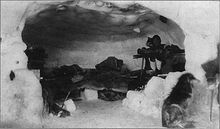Igloo
[2] In the Inuit languages, the word iglu (plural igluit) can be used for a house or home built of any material.
[1] The word is not restricted exclusively to snowhouses (called specifically igluvijaq, plural igluvijait), but includes traditional tents, sod houses, homes constructed of driftwood and modern buildings.
[3][4] Outside Inuit culture, however, igloo refers exclusively to shelters constructed from blocks of compacted snow, generally in the form of a dome.
[5] Several Inuit language dialects throughout the Canadian Arctic (Sallirmiutun (Siglitun), Inuinnaqtun, Natsilingmiutut, Kivalliq, North Baffin) use iglu for all buildings, including snowhouses, and it is the term used by the government of Nunavut.
Iglu is used for other buildings, while igluvijaq,[8] (plural igluvijait, Inuktitut syllabics: ᐃᒡᓗᕕᔭᖅ) is specifically used for a snowhouse.
[9][10] Snow igloos are not spherical, but are built in a catenary, a curved shape more closely resembling a paraboloid.
However, later the snow bricks are often cut into five- or six-sided shapes to increase structural interlocking,[13] similar to the stones used in the architecture of the Inca Empire.
Igloos used as winter shelters had beds made of loose snow, skins, and caribou furs.
The igloo is architecturally unique in that it is a dome that can be raised out of independent blocks leaning on each other and polished to fit without an additional supporting structure during construction.


